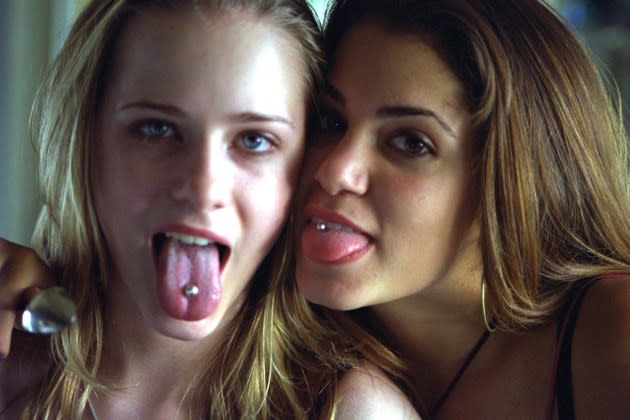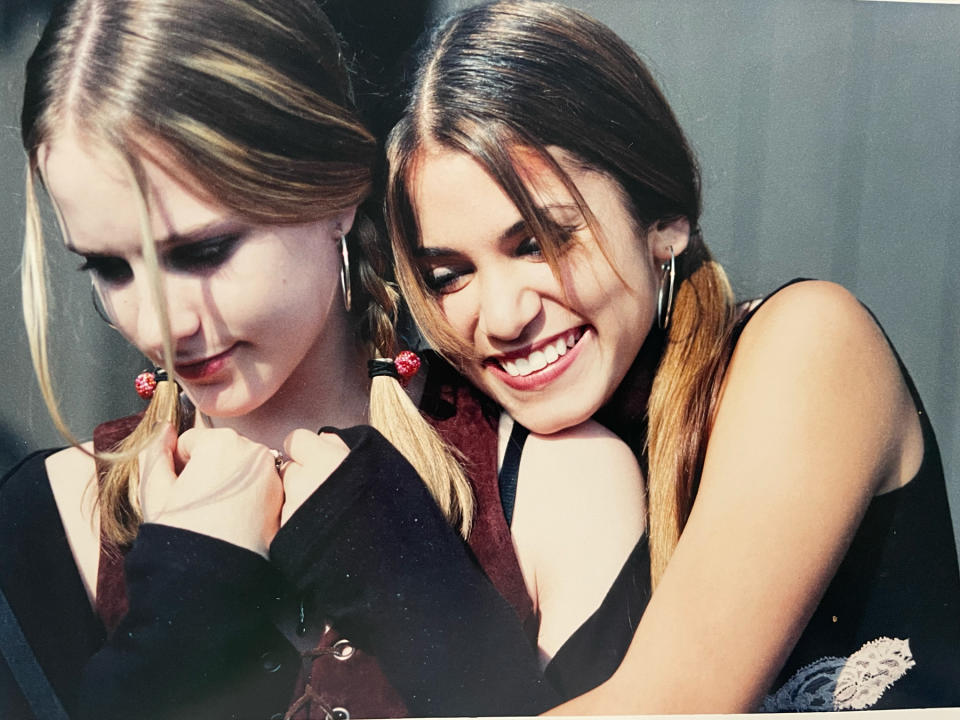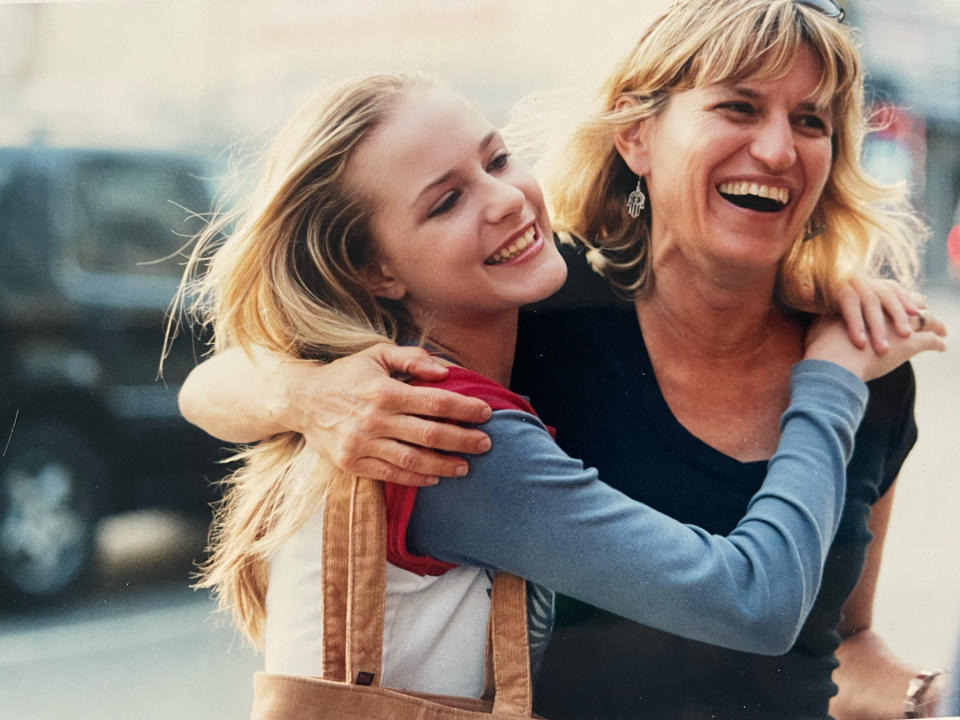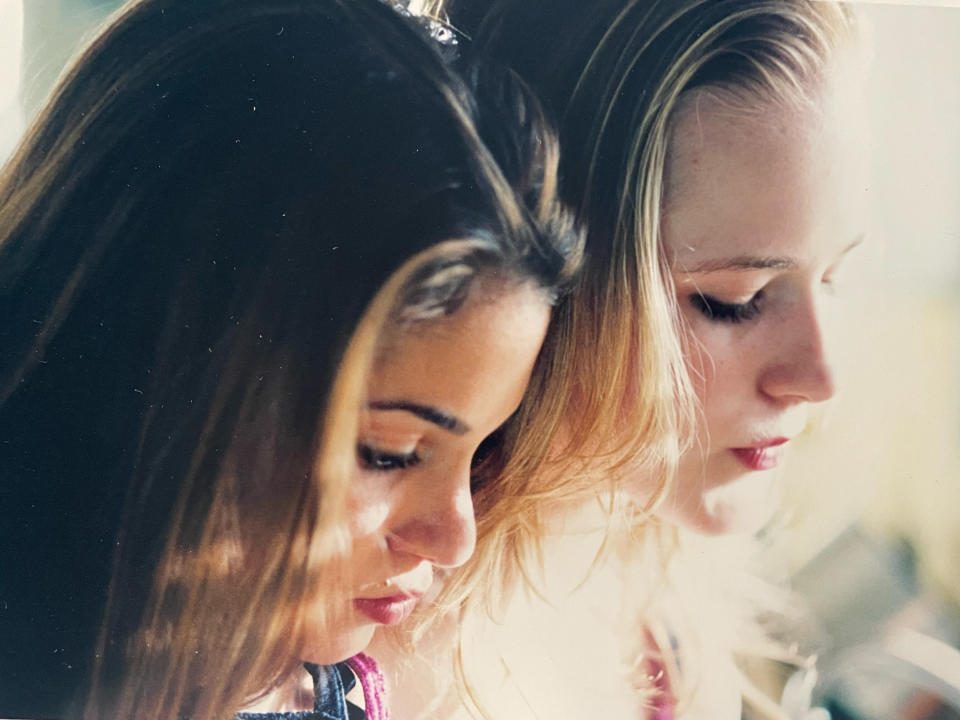‘Thirteen’ Is Twenty Years Old — But More Powerful Than Ever
- Oops!Something went wrong.Please try again later.
- Oops!Something went wrong.Please try again later.
- Oops!Something went wrong.Please try again later.
- Oops!Something went wrong.Please try again later.

On a recent day at the beach, actress Nikki Reed was basking in the California sun when a 15-year-old girl approached her. “I would love to take a picture with you!” the young fan exclaimed. Her interest in Reed, however, had nothing to do with her role as vampire Rosalie Hale in the mega-popular Twilight movies.
“Thirteen is my favorite film in the world,” the teenager said. “It actually inspired me to want to write and I already wrote my first screenplay.”
More from Rolling Stone
'San Francisco Sounds' Reveals the Discovery of Janis Joplin
Netflix Exposes How the Sacklers Sold Sex to Trigger an Opioid Killing Spree
Although she’d long been conscious of the impact Thirteen — which Reed co-wrote at just 13 years of age and ultimately starred in — had in the early aughts, the unexpected encounter still electrified her.
“I don’t even think she was alive when we made that movie,” the actress told Rolling Stone. “And here she is saying she’s written a screenplay because she was so inspired by me writing at such a young age.”
This month marks the 20th anniversary of the release of Thirteen, the debut feature from director Catherine Hardwicke. Reed plays Evie Zamora, a renegade teen who befriends mild-mannered Tracy Freeland (Evan Rachel Wood). Together, they dive headfirst into a self-destructive cycle of sex, drugs, and petty crime in pursuit of autonomy, leaving Tracy’s mother, Melanie (an excellent Holly Hunter), blindsided by her daughter’s abrupt change in character.
The film’s unflinching depiction of the pangs of modern-day adolescence — self-harm, drug use, parent-child showdowns, sexual awakening — proved too scandalous for some back when it hit theaters in 2003. But it remains a defiant work of American independent cinema, as viscerally truthful today as it was for young millennials back then.
“Last I saw there were 1.8 billion engagements with Thirteen on TikTok,” says Hardwicke. “People show a little clip, ‘This happened to me last week with my mom,’ and act out a scene. It still has relevance because how often do people really make a raw movie like that?”
Hardwicke still lives in the same Venice Beach property, mere blocks from the ocean, where she and Reed co-wrote the screenplay to Thirteen, and where Reed first met her co-star, Evan Rachel Wood. What used to be her home today serves as Hardwicke’s office. (She resides in a separate unit, purchased with her Twilight earnings, within the same complex.)

The airy working space is home to small shrines of the movies Hardwicke’s directed over the last two decades. Behind glass sits her original copy of the screenplay to Twilight and the piece of paper where Paramore’s Hayley Williams wrote one of the songs for the film. There is, of course, a corner honoring Thirteen featuring the laptop that belongs to Tracy in the drama, behind-the-scenes photos of the production, and even lobby cards from the original release.
“Heath Ledger sat right there,” Hardwicke says while pointing at a chair. “And up there is where Nikki and Evan had a sleepover when they first met,” the lively filmmaker notes about a luminous loft that overlooks the main living area. Posters of most of her projects as a director, including Lords of Dogtown starring the late Ledger, adorn the walls.
That these rooms function both as the place where she plans her upcoming projects and as a miniature museum for her creative memories feels natural. Hardwicke first studied architecture and began her film industry career as a successful production designer.
In the late-Eighties, Hardwicke moved from Austin, Texas, to Los Angeles to attend UCLA.
There, she first dabbled in animation and eventually found her way to production design jobs. As she climbed her way to established studio productions, Hardwicke enrolled in workshops on acting, directing, and screenwriting. By the early 2000s, she’d collaborated with the likes of David O. Russell, Richard Linklater, Cameron Crowe, and Lisa Cholodenko. But when Hardwicke tried to transition into filmmaking, companies refused to green-light her screenplays.
“David’s first movie Spanking the Monkey was $75,000 and Richard’s Slacker was 7,000,” she recalls. “I thought, ‘I gotta write a low-budget movie so nobody can stop me.”
Hardwicke took a six-month job in Canada and upon her return, she noticed how Reed, whose family she’d been friends with for a long time, had undergone a transformation and now constantly fought with her mother.
“She had completely changed,” says Hardwicke. “Before she was a cute kid, riding bikes, climbing trees, wearing overalls, and now she was baby J.Lo. I saw this real dark cloud over her.”
Aware that the family couldn’t afford traditional therapy, Hardwicke stepped in to try to engage the young Reed in positive extracurricular activities like surfing, drawing.
“She was like the fun big sister, aunt-type person that would take me to all these cool experiences,” Reed says. Hardwicke tried to find acting classes for Reed, but the only ones available were geared toward either adults or young children.
“I thought, ‘We’re gonna have to write our own film that’s more appropriate for you and your vibe. You’ll star in it, and I’ll direct it. I guess this will be our therapy to help you do something creative,’” Hardwicke recalls.
Uncertain of whether anything would come of it, Hardwicke suggested they write a teen comedy. But the more she understood what teenage girls like Reed were going through, the more she feld like those were the issues they should be exploring.
The two set out to write a full draft of a screenplay based on Reed’s personal experiences over the teen’s holiday break (six days between Christmas and New Year’s). Hardwicke remembers how the two of them would act out every scene as they were putting them down on the page. One of those days, Hardwicke recalls Reed having a phone conversation that suddenly went from cheery to a heated argument within a matter of seconds.
“At first, I was about to say, ‘Nikki, don’t pick up the phone anymore. We only got six days,’” says Hardwicke. “But then I realized that’s what this movie’s about. It’s about those emotions and that volatility and that crazy turmoil that she’s going through.”
For Reed, it was only after the movie’s release and promotion that she began to grasp the significance of being so vulnerable during the genesis of this life-changing project.
“I was just a kid, and so I grew up as the world was watching this film,” Reed says. “Maybe I would describe those experiences being more cathartic as opposed to the writing process. I was unaware when we were writing that there was anything being processed at the time.”
After revising the screenplay, mostly to make the mother character more layered, Hardwicke put a photo of an innocent Reed wearing Dungarees on the cover and decided on the title. She carried copies in her car until she met producer Michael London at a party and gave him the pitch. He called her the next morning promising to make the film a reality.
According to Hardwicke, the role of Tracy was originally meant for Reed. But over the course of the audition process, the director realized that none of the 13-year-olds vying for the part of Evie were as sophisticated as Reed. Refusing to opt for casting a more mature 17- or 18-year-old, Hardwicke broached the idea of Reed playing Evie.
“It was very well-known that this story was semiautobiographical, and that Tracy was based on me,” Reed says. “But because I played Evie — who is very wild and rebellious — I was associated with that character for a very long time, when the truth is, I was actually a very shy kid and that was definitely a performance.”
Hardwicke had seen Evan Rachel Wood on the television series Once and Again, where she played an introverted preteen struggling with disordered eating, and sensed that she had the right intensity to play Tracy. Her suspicions were confirmed when they met.
“She knew the character and she felt it,” Hardwicke explains. “She was living and breathing as this girl and was so close to her heart.”

Having grown up in her Culver City bubble, as she puts it, Reed recalls being in awe of Wood’s presence and her acting chops even at that age. She had never met anyone like her.
“I loved Evan from the moment I met her,” says Reed. “She is a very special person in my life. When we were teenagers, life got busy and we lost touch for a few years, but in our early twenties, we reconnected on a level I can’t even explain. I love her like a sister.”
Determined to make the movie “by hook or by crook,” Hardwicke paid for Reed to take acting classes with Wood’s acting coach, Andrew Magarian. Reed would continue working with Magarian for many years after completing Thirteen.
As the movie began to take shape, London arranged for Hardwicke to meet with Holly Hunter’s manager about playing Tracy’s mother. The director’s sincere pitch got their attention, so she flew out to New York to meet Hunter the next day. That afternoon, Hardwicke recorded a video of Reed’s mother, Cheryl Houston, candidly asking Hunter to play her in the movie. According to Hardwicke, the realism grounding the story enticed the Oscar-winner, who agreed to play the role after the director made some tweaks to the character.
With Hunter on board, Hardwicke met with Fox Searchlight, already a force in releasing visionary independent works. But because Hardwicke wouldn’t remove scenes involving self-harm, drug use, and cursing, Searchlight wouldn’t support its production. However, if the film got into the Sundance Film Festival and they liked the end result, they agreed to purchase it for distribution. Ultimately, Working Title split production costs with Antidote Films. Its budget was just under $2 million.
In order to cut costs, Hardwicke planned to shoot the film at her home in Venice Beach — only to realize that since it’s under in an air-traffic pattern, the noise from airplanes would be too disruptive.
Instead, she rented a house in the Valley and, following Richard Linklater’s advice about having ample rehearsal time with the cast, she convinced the owner to allow them to be there for an extra week at no additional cost. That time living together in the rental home and rehearsing forged strong relationships between cast and director.
“Catherine helped to facilitate these real bonds between all of us. But at the time, I was so unaware of how unusual that process is,” says Reed. “You don’t get to do that very often. I just thought it was wonderful that I was having sleepovers with friends.”
Because Wood and Reed were minors, their time on set was limited, and 21 days of shooting turned into the equivalent of 18 days. Hardwicke was blown away by Wood’s ability to turn on her emotions to keep up with the production’s frantic pace. “Sometimes we would film a dozen scenes in one day,” Hardwicke maintains. “Evan had one take on a lot of those.”
The main tenet Hardwicke followed when it came to directing teenagers was to never assume that she understood the characters better than they did.
“They knew more than I did about being that age at that time and I tried to listen to them and cared about what they thought,” she says.
There’s a visual energy to Thirteen that comes from Hardwicke observing Reed’s chaotic home life. Rather than looking at other teenage movies, she watched war movies. The Killing Fields came to mind, given the way the camera at times misses a bomb going off while on the move. Hardwicke hoped to place the audience in the middle of these “battles” that the kids have with each other and with their parents.
“A lot of scenes have that energy,” says Hardwicke. “I really wanted to have moving master [shots]. I wanted to play the scenes out as long as I could, so that it would be more real, not made in the editing room — if I could help it.”
One scene, when Evie and Tracy visit their handsome neighbor, is a continuous shot running nearly three minutes long.
“I had a wonderful cinematographer, Elliot Davis, who’s very sensitive,” says Hardwicke. “We shot on super 16mm film. He’s got the camera on his shoulder and he’s breathing with the actors. He’d do snap zooms, but if he felt you were getting more intense, he’d refocus.”
For every scene, Hardwicke, who trained as an architect, used copies of the home’s blueprint to create a diagram of how the camera should move through the space. There were no dollies, tripods, or other equipment — only a handheld camera with the actors.
Hardwicke admits that because they were running low on funds, the footage in the film captured on Hollywood Boulevard and when Wood takes the bus early on were shot without permits. Davis would shoot inconspicuously, hiding the camera when needed. With no money for clearances, Hardwicke also had to create the makeup billboard seen throughout Thirteen using a photo of Reed’s eyes and another person’s mouth. The poster read “Beauty is Truth” and aimed to illustrate the influence advertisements have on young people.
“From writing the film to premiering at Sundance it was exactly one year, which is just unheard of and is a testament to Catherine’s energy and her passion coupled with people hearing that a 13-year-old girl was the co-writer of this film,” Reed says.
Following principal photography, Reed started high school, blissfully unaware that what they’d filmed over the summer could change the course of her life — that is, until she was asked to do an interview prior to the movie’s release for a teen magazine that included Mandy Moore, a major pop star at the time. “That was a real turning point for me, being next to Mandy Moore in this magazine and realizing, ‘Oh my gosh, we made a real movie,’” offers Reed.

In the end, Fox Searchlight kept their word and bought the movie at Sundance. Hardwicke would go on to win a directing award at the festival. Prior to its Aug. 2003 theatrical release, Searchlight sent Hardwicke on a multi-city tour to screen the movie and then hold post-screening conversations with a variety of experts who dealt with troubled youth.
She recalls how parents were incredulous of the damaging acts the characters engage in.
“Thirteen-year-old kids are not like that,” some attendees would righteously say. But when the child therapist or addiction counselor on hand would chime in, they explained that what made it on screen seemed was tame in comparison to what they’ve witnessed on a daily basis.
After screening at over 50 film festivals around the world, Thirteen earned Reed an Independent Spirit Award for Best Debut Performance. Hunter received Academy Award and BAFTA nominations for her work. Meanwhile, Wood became the youngest actress to land a SAG Award nod in the Leading Role category at the time.
Twenty years on, Hardwicke knows it was Thirteen that allowed her to have a shot at a prolific career despite the “leaky pipeline” for women directors in Hollywood. Everyone from an 83-year-old woman she met in New York City, to actress Margot Robbie, and even electronic music star Skrillex have professed their adoration for the film to Hardwicke.
Over the years, she’s pitched a TV show based on Thirteen that would explore the lives of 13-year-olds in different cultural contexts, which she still hopes to make someday.
Thinking of herself at 13, Hardwicke identifies most closely with Noel, Tracy’s timid pal (played by a young Vanessa Hudgens).
“I would be the nerdy, totally-scared-in the-corner friend,” she says. “Everybody else is playing spin the bottle and I’m hiding behind somebody so that the bottle won’t land on me, and I won’t have to admit I don’t have anything exciting to say.”
Thankful (and still surprised) for the path this adventure set her on, Reed believes that to make Thirteen today, details would have to be updated to reflect a world that has drastically changed, with social media proving a crucial aspect of how young people interact now. Yet, she is also sure that the core thematic pillars of the film would remain intact, and resonate.
“Relationships between moms and daughters will always be a complex road to navigate,” says Reed. “Opening up that type of dialogue will always have impact on people.”
Later in life, as she traveled abroad to promote her subsequent projects with Hardwicke — Lords of Dogtown and Twilight —Reed always felt a special kinship with people who’d approach her to share how formative, and even life-saving, Thirteen was for them.
“Both [Catherine] and I can agree that neither of us had any idea what it would become,” Reed says. “The magic of it was that we took a very truthful, honest, and specific moment and somehow it turned into this global phenomenon.”
Best of Rolling Stone

